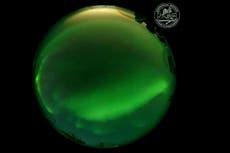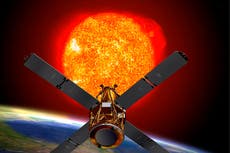How to watch rare ‘hybrid’ solar eclipse today
‘During the eclipse, that lasts only a few minutes, the entire world around you gets dark’
A very rare “hybrid” solar eclipse spanning the southeast Asia and Pacific Ocean regions could shroud parts of Australia into darkness.
The solar eclipse on Thursday, the first for this year, will block out the sun over Australia, the eastern Indonesian islands and East Timor. The eclipse is due to take place between 1.34am UTC and 6.59am UTC on 20 April.
A solar eclipse occurs when the moon, passing around the Earth in its inclined orbit, casts its shadow on the planet as it passes between the planet and the sun.
This can be classified as either a total eclipse – one in which the moon completely covers the sun – or an annular one in which the moon is further away from Earth in its orbit, and shrouds almost all of the sun, except an outer ring that remains visible as a bright.
The very rare “hybrid” astronomical event is a combination of both a total and an annular solar eclipse. There have been only seven of these in the current century and the next one is slated to appear over North America on 14 November 2031.
“The 20 April 2023 hybrid solar eclipse is notable in that it is longer in duration than most annular-totals, and is the longest until 17 October 2172,” solar eclipse mapper Michael Zeiler told space and astronomy news portal Universe Today.
People in some parts of the world will see a total eclipse while some others are expected to find an annular one, depending on where they live along Earth’s curved surface relative to the moon.
Millions of people living across southeast Asia, including in Singapore, Jakarta and Manila, as well as those in Australia, can get partial views of the eclipse as the moon makes its path around the Earth.
In Sydney, about a 20 per cent coverage by area of the sun is expected, starting from 1.37pm local time.
But sky gazers living in a stretch from Antarctica to Western Australia (WA), including the country’s north west Ningaloo coastal region, are expected to see a total eclipse.
People in the small, remote town of Exmouth in WA will be able to see the perfect alignment of the sun, moon and Earth for about a minute.
There are also two regions in the middle of the Indian Ocean from where the eclipse will be seen transitioning from annular to total and then back again.
“During the eclipse, that lasts only a few minutes, the entire world around you gets dark. This is a spectacular unique natural phenomenon that reminds us how small we are in the grand universe,” Katarina Miljkovic from the Space Science and Technology Centre at Curtin University said.
“Given that two-thirds of our surface is covered by oceans, it is very frequent that the path of the totality falls on the oceans, where it is extremely hard to witness the event.”
“This year, we are extremely fortunate to be able to observe the solar eclipse from WA,” Dr Miljkovic said.
On this rare event, Nasa is also testing the use of a kite to study the sun’s outer atmosphere.
A team led by University of Hawaii astronomer Shadia Habbal will use a large kite to lift a scientific instrument to about 3,500ft (about 1km) above the Australian landscape to understand how charged particles like electrons and protons escape the sun to form the solar wind.
“A total solar eclipse is something that will not be with us forever! It requires the moon to totally cover the sun. But the moon is moving away from us and so we will only have eclipses for another 600 million years. Best to look at them now, while you have the chance!” John Lattanzio, president of the Astronomical Society of Australia said in a statement.
Join our commenting forum
Join thought-provoking conversations, follow other Independent readers and see their replies
Comments


Bookmark popover
Removed from bookmarks